Mars Desert Research Station End of Mission Summary
Crew 174 – Team PLANETEERS
Team PLANETEERS (All Indian Crew):
Commander: Mamatha Maheshwarappa
Executive Officer/Crew Scientist: Saroj Kumar
Engineer/Journalist: Arpan Vasanth
GreenHab Officer: Sneha Velayudhan
Crew Health & Safety Officer/Geologist: Sai Arun Dharmik
Success occurs when your dreams get bigger than your excuses
The Solar System is a tiny drop in our endless cosmic sea (Universe). Within our solar system, a very few planets host an environment suitable for some life forms to exist. The closest one being Mars after the Earth, following the success of rovers such as Spirit, Opportunity, Curiosity and several space probes, the human understanding of the planet has reached new levels. The next important aspect is to find out if there exist any life forms or if the planet had hosted any life in the past. Although the rovers send out a lot of information about the planet, so far humans have not found anything substantial. With advancements in science and technology by organizations such as NASA, ESA, ISRO, CNSA along with private industries such as SpaceX manned mission to Mars seems to be within reach in a few years. To carry out successful missions humans will have to develop key tactics to cope up extreme conditions, confined spaces and limited resources. Team Planeteers (MDRS Crew 174) is the first all Indian crew consisting of five young aspirants from different domain who have come together to embark on a special mission in order to develop such key tactics. The crew was successful in executing the planned experiments. The key for their success is the temperament and dedication shown by each individual and fixing small issues immediately. Since all the members were of same origin, food and cultural aspects was an advantage. Going forward the team is planning out for outreach activities. As a part of QinetiQ Space UK, Mamatha will be involved in outreach, education and media activities (TeenTech & STEMNET). Similarly, Saroj and Sneha will be conducting STEM outreach activities at Unversity of Alabama and Rochester Institute of Technology respectively.

Figure 1 Team Planeteers inside the MDRS Hab
Research conducted at MDRS by Crew 174:
- Characterizing the transference of Human Commensal Bacteria and Developing Zoning Methodology for Planetary Protection
The first part of this research aims at using metagenomics analysis to assess the degree to which human associated (commensal) bacteria could potentially contaminate Mars during a crewed mission to the surface. This involved collection of environmental soil samples during the first week of the mission from outside the MDRS airlock door, at MDRS airlock door and at increasing distances from the habitat (including a presumably uncontaminated site) in order to characterise transference of human commensal bacteria into the environment and swabbing of interior surfaces carried out towards the end of the mission within the MDRS habitat to characterize the commensal biota likely to be present in a crewed Mars mission. In the interests of astrobiology, however, if microbial life is discovered on the Martian surface during a crewed mission, or at any point after a crewed mission, it will be crucial to be able to reliably distinguish these detected cells from the microbes potentially delivered by the human presence.
The second part of the research aims at testing the hypothesis that human-associated microbial contamination will attenuate with increasing distance from the Hab, thus producing a natural zoning. The previous studies hypothesize that there may be relatively greater contamination along directions of the prevailing wind because windborne particles or particle aggregates allow attachment of microbes and help to shelter them against various environmental challenges, e.g. desiccation, ultraviolet light, etc. Efforts are afoot to try to develop a concept of zones around a base where the inner, highest contamination zone is surrounded by zones of diminishing levels of contamination occur and in which greater Planetary Protection stringency must be enforced (Criswell et al 2005). As part of that concept, an understanding of what the natural rate of microbial contamination propagation will be is essential.
a. Sample collection process:
Two sets of samples were collected as the analysis will be carried out at two different stages.
i. Samples of the soil outside the MDRS were collected aseptically into sterile Falcon tubes. Sampling sites included immediately outside the habitat air lock (with presumably the highest level of human-associated bacteria from the crew quarters), at increasing distances from the airlock along a common EVA route (to track decrease in transference with distance), and at a more remote site that ideally has not previously been visited by an EVA (to provide the negative control of background microbiota in the environment).
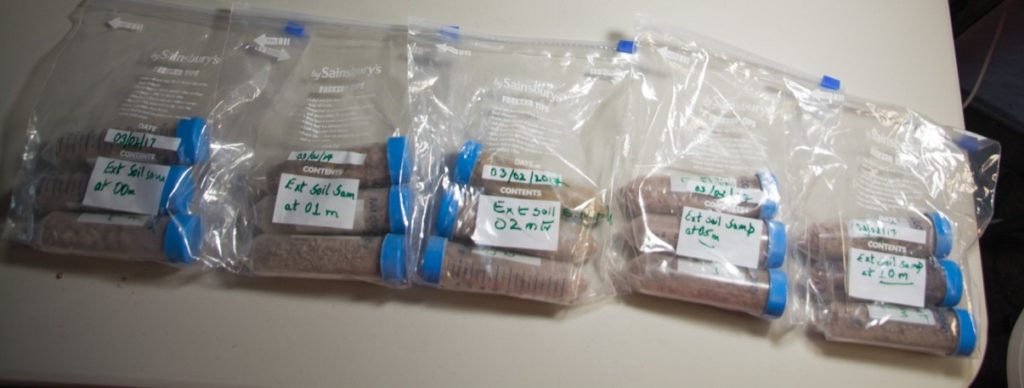
Figure 2 Soil Samples collected at increasing distances from the Airlock
ii. Various surfaces within the crew quarters were swabbed using a standard sterile swab kit to collect microbes present from the course of normal human habitation. These included door handles, walls, table surface, airlock handles, staircase, working table, computer. This did not expose the science team to additional infection risks (such as not swabbing toilets).

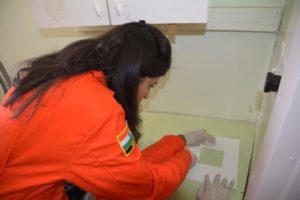
Figure 3 (a) Sterile Swab Kit (b) Internal swab collection (working table)
Sampling locations within the habitat and soil sampling sites during EVA were recorded by photographs and written notes. After collection, the samples were refrigerated at the MDRS Science lab, and then returned with the crew to London for storage and analysis. This is analogous to medical samples being collected from ISS astronauts and returned to Earth for lab analysis. The molecular biology sample analysis and data interpretation, including all the metagenomic analyses to identify bacterial strains present, will be conducted by Lewis Dartnell in collaboration with John Ward. The collaboration agreement is already in place and lab space and resources confirmed. The analysis is carried out in two different stages:
a. Stage 1 Analysis:
The first set of samples will be tested using off-the-shelf simple tests for the presence or absence of human associated microbes, namely coliforms. These are simple to use and give a yes/no answer, so plots will be made of yes/no results with distance from the hab in different directions. This could be correlated with prevailing wind directions and/or to show common human pathways from the hab versus directions in which people typically don’t go.
b. Stage 2 Analysis:
The second set of samples (internal swabs) will not be cultured or otherwise processed back on Earth (as culturing of human commensurate and environmental microorganisms could present a biological hazard to the MDRS astronauts). All sampling materials and storage containers were provided by the study, and thus will require no consumables or other resources from the MDRS. All sample collection pots and sampling materials will be removed by the study scientists, and the sampling process itself (small soil samples and surface swabs) will not impact the MDRS habitat or its natural environment.
- Zoning and sample collection Protocols for Planetary Protection
Planetary protection is one of the major subjects that require immediate attention before humans travel to Mars and beyond. MDRS being one of the closest analogues on Earth with respect to dry environment on Mars was the best site to perform and simulate issues related to planetary protection. Our work on planetary protection was to simulate zoning protocol to be used to manage relative degrees of acceptable contamination surrounding MDRS and implementation of sample protocols while at EVA’s for soil sample collection, geological study and during hab support activities etc.
a. Zoning protocols for crew exploration around MDRS
During the mission, we extensively studied the zoning protocol in and around the hab and how contamination issues on Mars can be restricted. On the first day on ‘Mars’ we used the geographical map of MDRS exploration area to formulate and characterize zones around the hab and the strategy for sample collection.
i. Zone: 1 (Area within Hab) – This area is believed to be the most contaminated with the human microbes.
ii. Zone 2 (About 20 meters from the hab) – This is the area where most of the hab support systems and rovers are parked. This zone is supposed to have less microbial contamination than hab but higher than Zone 3 and 4.
iii. Zone 3 (Beyond 20 meters but within 300 meters around the hab) – This area is considered to have regular human presence during an EVA. Soil samples of Zone 2a and 2b were collected for future analysis in lab to study human microbial contamination.
iv. Zone 4 (Special Region) – This area was considered to have insufficient remote sensing data to determine the level of biological potential. This area was marked as no EVA zone and can only be studied in detail by remote sensing data using satellites or drones.
b. Sample collection protocols
The crew studied the sample collection protocol requirements for all the activities such as soil sample collection, geological study and during the operations of hab support systems etc., this was to avoid forward and back contamination. The protocols were planned to be initiated from the time a crew member leaves the airlock for EVA and until he/she returns from the EVA to Hab. During the EVA, the crew noted every experiment procedure and made sure there was no breach in spacesuits and no human microbial contamination during soil collection. The tools used for the soil collection were required to be completely cleaned and sterilized. The study of rocks on site during an EVA was one of the major challenges where it was realized that special tools were required to pick the rock samples without getting them exposed to spacesuit gloves. Using only gloves to pick rock samples could also rupture the spacesuits and thus there could be a decompression issue. Even with a detailed geological exploration map of MDRS and high resolution satellite imagery, it was noted that the use of drones can drastically reduce the human EVAs and lots of geological and terrain information can be obtained in a shot span of time. This step would heavily reduce the human EVA and thereby contamination issues to special regions where there could be a possibility of having a biological activity. Water, a major carrier of human microbes is proposed to be within the structures of hab. During the simulation, the crew made sure that there was no water spillage outside the hab.
- Development of New Techniques to Enhance Plant Growth in a Controlled Environment
A crewed mission to the Mars demands sufficient food supplies during the mission. Thus cultivation of plants and crops play an important role to create a habitat on Mars. There are some factors to be considered before cultivating crops on the Martian surface. First, the planet’s position in the solar system, Mars receives about 2/3rd of sunlight as compared to the Earth that plays a vital role in crop cultivation. Second, the type of soil used for crop cultivation should to be rich in various nutrients. Since the MDRS site is considered as one of the best analogue sites on Earth to simulate Mars environment, the experimental results of plant growth at MDRS was considered for this research. This research aims at growing fenugreek (crop that is rich in nutrients and grows within the mission time) to determine the effect of Vitamin D on the growth.
At MDRS, the fenugreek seeds were allowed to germinate for 2 days. In the mean-time, an EVA was carried out to collect soil from different parts on ‘Mars’. The soil was collected based on the colour and texture. Five types of soil, white (01), red (02), clay (03) coloured soil, course grey soil (04) and sand from river bed (05) were collected. Two set of experiment pots were made as shown in the Figure 4. Each had 15 pots, 10 pots with Earth soil (ES) labelled with different levels of Vitamin D (0- 0.9) and 5 pots of Mars soil (MS) labelled according to the area of the soil collected (0-5). One set of 15 pots was placed in the Green hab and the other in the controlled environment (under the Misian Mars lamp) after planting the well germinated seeds. The plants were watered twice a day in order to maintain the moisture in the soil.
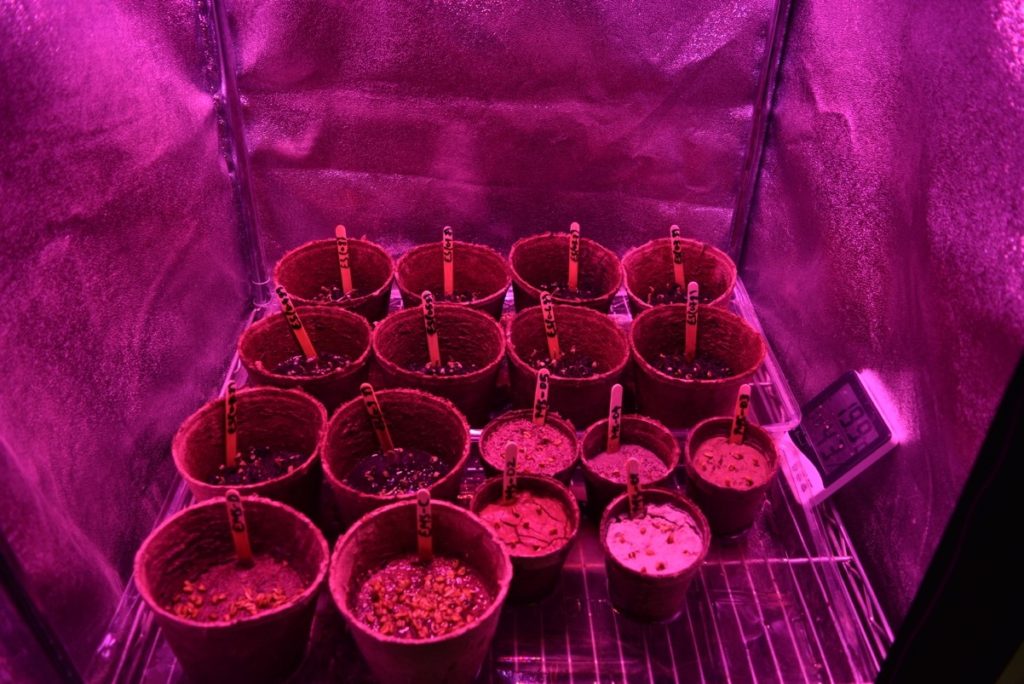
Figure 4 Experimental Setup with Earth and ‘Mars’ Soil
The temperature and humidity levels were monitored twice a day throughout the mission both in the green hab and the controlled environment (Misian Mars Lamp). It was noted that there was a steep increase in the temperature in the green hab as the outside temperature was high that inturn decreased the humidity in the green hab drastically. The situation was managed by switching on the cooler and then by monitoring the heater thermostat. The plants were watered with specific measurement of Vitamin D every day. The experiment was successfully completed by monitoring the growth regularly, it is evident that humidity and temperature impacts the growth of plants. The plants in the green hab showed more growth of primary root than the secondary, the leaves were normal in colour and growth. In the controlled environment, the root growth was fast, the plants developed many secondary roots in few days. The plants looked healthy, the leaves were dark green and bigger than the ones in the green hab as seen in Figure 5.
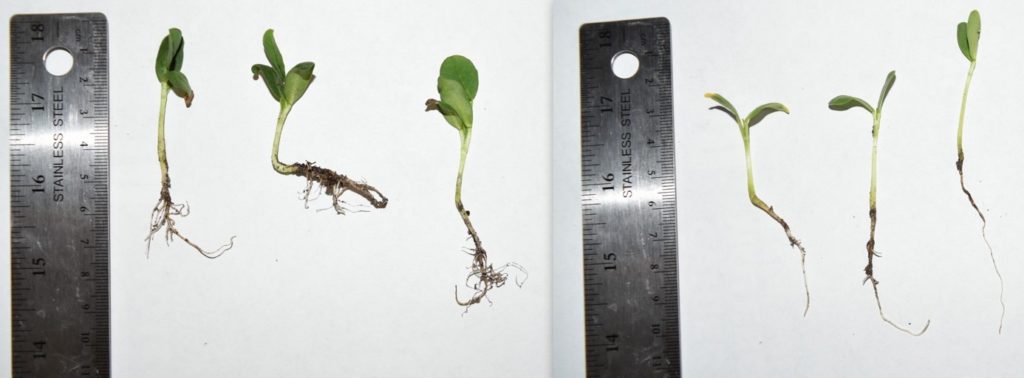
Figure 5 Plant growth in (a) Misian Mars Lamp (b) GreenHab
In conclusion, the graphs were plotted for the root growth for the Earth Soil with Vitamin D in the green hab and the controlled environment from Sol 08 to Sol 13. The graphs indicated that the low level of Vitamin D (0.1) enhances root growth in the green hab. Under misian Mars lamp, the growth rate is high for ES 0 (without Vitamin D). Readings tabulated for the Mars soil was plotted on daily basis but, after few days it was noted that there was neglibile growth in the Mars soil. The graphs plotted for few days are as shown in the Figure 6.
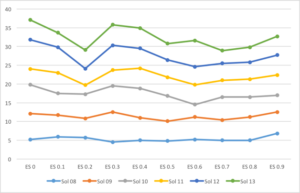
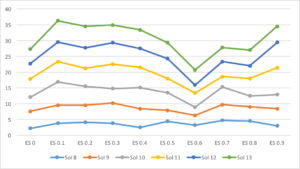
Figure 6 Root growth of seedlings (a) Misian Mars Lamp (b) GreenHab
- Study of magnetic susceptibility of the rocks and their comparison
The primary objective was to study the magnetic susceptibility and magnetic minerals of the rock samples collected and compare them with multi-spectral remote sensing data back in the lab. MDRS contains a range of Mars analogue features relevant for geological studies. It contains a series of sediments derived from weathering and erosion from marine to fluvial and lacustrine deposits containing also volcanic ashes (Foing et al. 2011). With the preliminary understanding of the MDRS geographical exploration area and identification of potential targets, the lithology can help us decipher the structural history of the region, with understanding of genesis of such rock types and aid exploration efforts. The previous studies done at MDRS reveals that the magnetic susceptibility did not vary significantly near the Hab. Hence, the locations of various geological formations far away from the hab were selected to study the distribution of magnetic minerals. The selected locations for the same were sedimentary outcrops, cattle grid, burpee dinosaur quarry, widow’s peak and near the Motherload of concretions.
We found layers of horizontally bedded sandstone and conglomerates, sandstones and siltstones. Some of them seem to have inverse grading which could have been created by the debris flow. Gypsum and lichens were spotted around the area of sedimentary crops. In the next visit to Motherload of concretions, we have seen a variety of lichens: yellow, black, orange and grey. And in the Cattle grid region, colors of mudstone and conglomerates bands of rich cream, brown, yellow and red were found. The basalt samples were collected from the gravel in the cattle grid region and from the URC north site (porphyr) to be studied in the lab. Near the widow’s peak, shales were found along with gypsum shining bright, distributed around that area. Most of the region was covered mostly with loose soil. The locations of all the samples collected from different regions were marked with the help of GPS. The magnetic susceptibility of rock samples were measured and documented them using the magnetometer in the science lab. Inspection of samples was possible with the microscope at the science dome, with 10X zoom as seen in Figure 4. They need to be studied in thin sections for better understanding and will be done on Earth under the guidance of specialists.
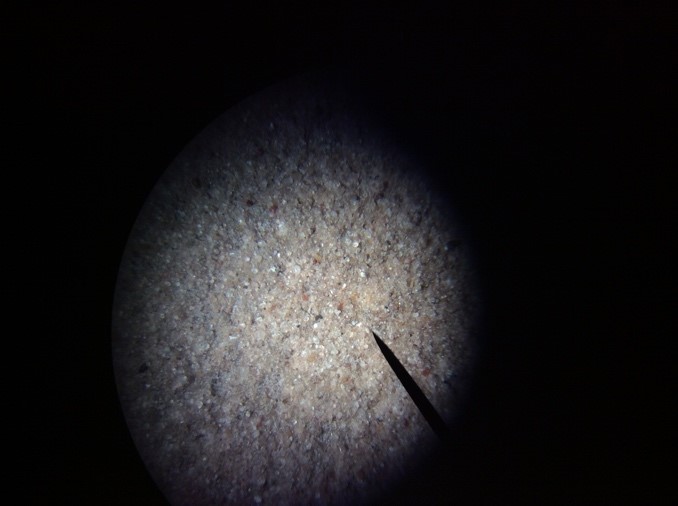
Figure 7 (a) Porphyr under microscope (b) Siltstone under the microscope
- Drone Experiment
‘Mars’ has a harsh environment that risks Extra Vehicular Activity (EVA). The main objectives of the drone experiment were:
a. To ease EVAs by understanding the scenario of a region that is hard to access by rover/ATV.
b. To simulate the application of drone in search of a crew member during an emergency situation and during loss of communication.
c. Video making and photography for outreach activities.
The first objective to make use of drone in isolated regions was successfully executed on Sol 07. Since it was the first trial, the drone was operated in beginner’s mode restricting the field of operation to 30m range. The crew was looking out for soil samples, when confronted by a medium size hill the drone was sent out to check for soil sample availability on the other side. The region looked to be same and it was easier for the crew to take a decision to abort the mission and move to a different location.
Execution date: Sol 07 (Earth date: 02/05/2017)
GPS Satellites: 13
Flight mode: Beginner’s mode of max 62 FT altitude and within 30m range.
The second objective was to simulate an emergency situation when one of the crew lost communication with other member during EVAs. The beginner mode range was too less and hence the drone was operated in advanced mode to search the missing crew member. The mission was successful in identifying the crew member.
Execution: Sol 11 (Earth date: 02/09/2017)
GPS Satellites: 14
Flight mode: Advanced mode with 121 FT altitude and 500m range.
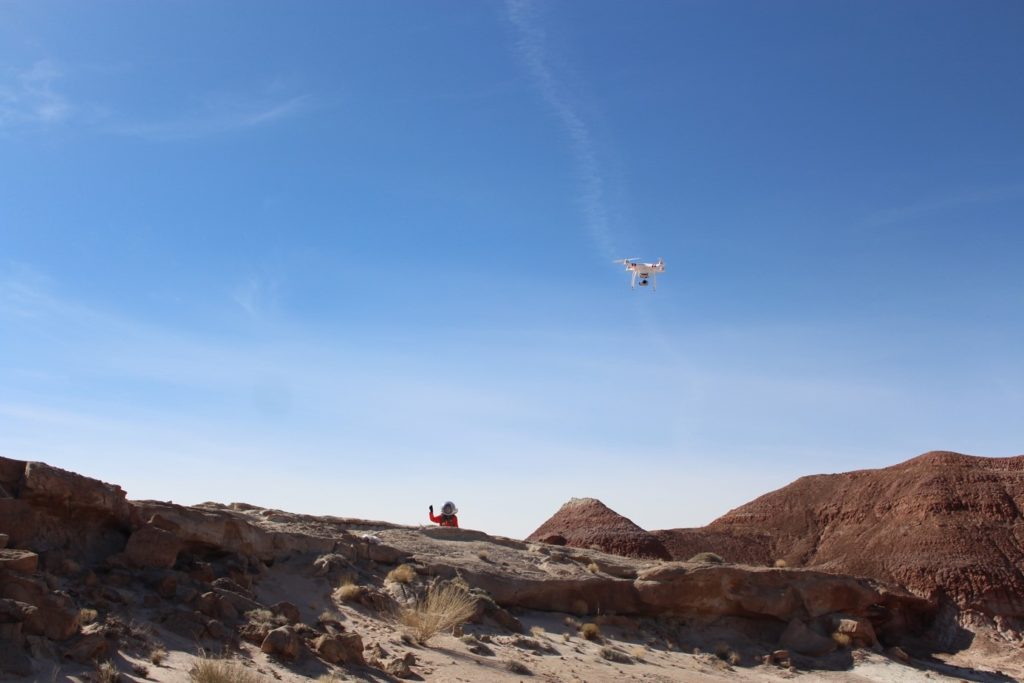
Figure 8 Drone Searching a Crew Member
Several photographs/videos were captured as per the planned outreach activity.




















